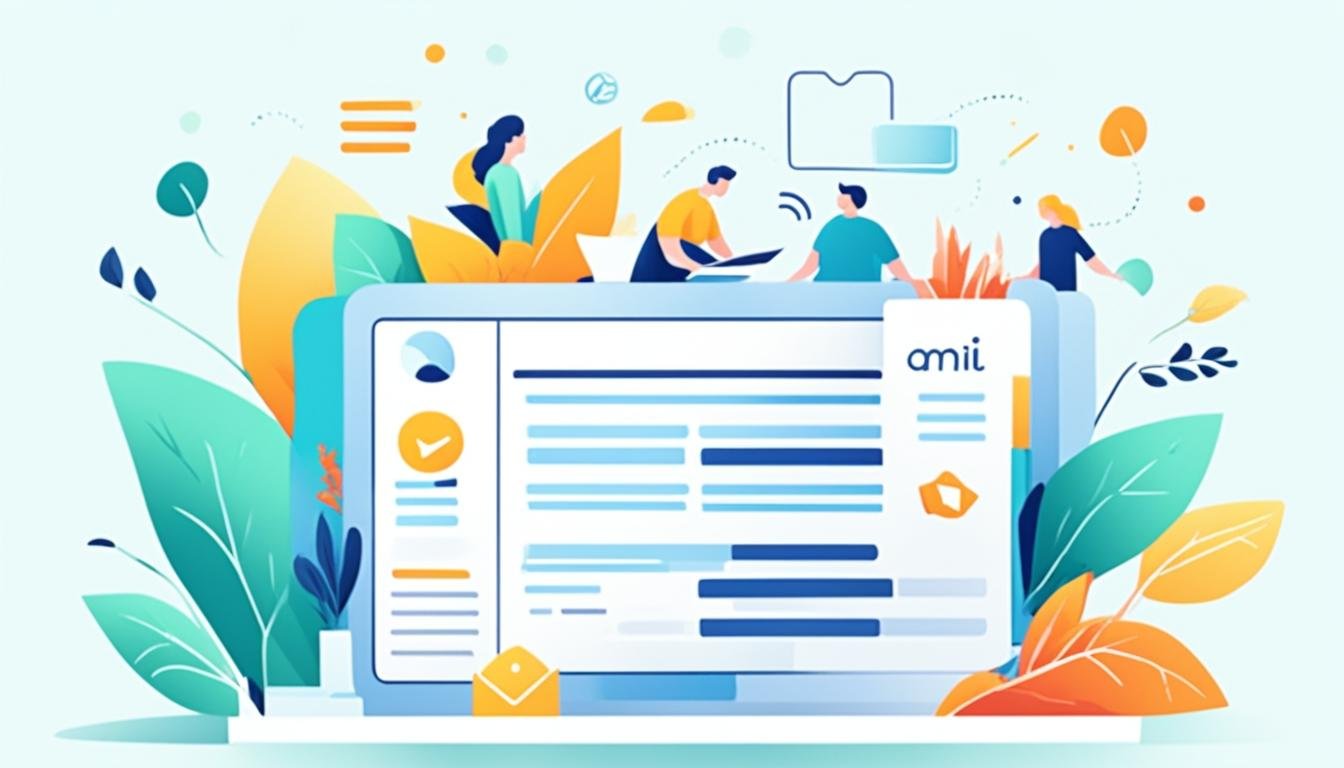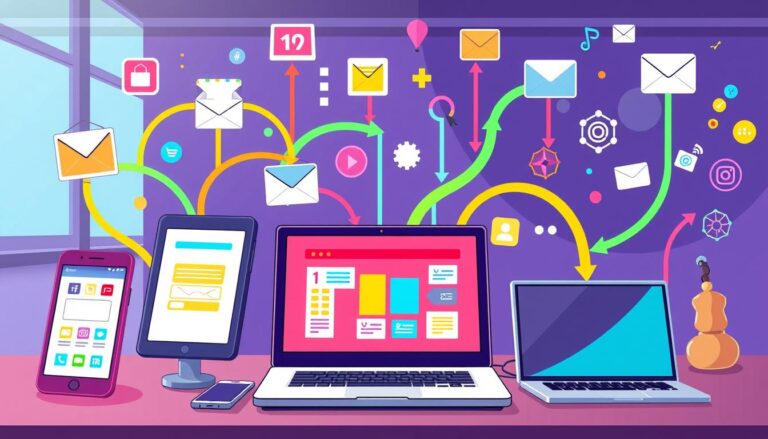Personalization in Email Marketing: Techniques for better engagement.
Did you know email marketing can bring in $44 for every $1 spent? Personalized emails can boost open rates by up to 26%. This shows how important personalization is in reaching your audience.
Generic emails just don’t cut it anymore. People want emails that feel made just for them. By using advanced techniques like dynamic content and segmentation, businesses can make emails that really speak to each person. This can greatly improve open rates, click-through rates, and overall engagement.
Personalized marketing emails go beyond just using someone’s name. They deliver content that matches the audience’s likes, actions, and background. Platforms like Really Good Emails help brands remember important dates for subscribers, like birthdays or anniversaries. This builds loyalty and makes people feel closer to the brand.
Personalized emails are not just more relevant. They make people feel noticed and heard. In this article, we’ll see why personalization is key in email marketing. We’ll look at various techniques to boost engagement, from the basics of personalization to using dynamic content and triggered emails. Let’s see how to make your email marketing strategy work better and build strong connections with your subscribers.
Key Takeaways
- Email personalization can boost open rates by up to 26%, enhancing engagement metrics.
- Dynamic content allows for tailored messaging, improving email communication’s effectiveness.
- Segmentation categorizes subscribers into groups, enabling targeted and relevant email marketing efforts.
- Triggered emails such as welcome or abandoned cart reminders significantly drive revenue.
- Using the recipient’s first name in the subject line can result in a 29% increase in email open rates.
Why Personalization in Email Marketing is Essential
Over half of the world’s people use an email every day. This makes email a key tool for marketers. Emails that are made just for you are 26% more likely to get opened, says Campaign Monitor. This shows how important personal touches are in email marketing strategies, since generic emails often don’t grab attention.
Tailored emails make people feel special and more likely to interact with the content. Personalized calls to action can boost conversion rates by 202%. This big increase shows how key targeted email marketing is for getting more sales. Emails with a personal touch get an 18.8% open rate, while generic ones get only 13.1%, according to Statista.
Personalized email marketing can also lead to a 600% revenue increase, as Experian points out. Such amazing results highlight how vital personalization is in email marketing. Personalized deals and content that matches what people like can bring in a median ROI of 122%. Also, Campaign Monitor shows that focused campaigns bring in 760% more revenue, proving the power of targeted emails.
In summary, the stats and benefits clearly show why personalization in email marketing is a must. From better open rates to more loyal customers, the data proves that personalized emails are crucial. Personalized subject lines alone can increase open rates by 26%, making them a key part of successful email marketing.
Understanding Email Personalization
Email personalization uses subscriber data to make content that speaks to each person. It’s more than just using names; it includes data like birthdays, shopping habits, and past interactions.
Definition and Importance
Email personalization means using subscriber data for tailored content. It helps build a strong bond with customers by making them feel special. With 71% of consumers expecting personalized communication, ignoring this trend can lead to missing out on engagement and revenue.
Personalized subject lines can boost email open rates by 26%. Segmenting email campaigns can increase revenue by up to 760%. Yet, less than 30% of marketers use email personalization, showing a big gap in marketing.
Benefits of Tailoring Content
Personalized email campaigns bring many benefits. They lead to higher engagement rates. Personalized subject lines and content that match the recipient’s interests increase the chance of action. Data shows that cart abandonment emails sent within 60 minutes have a 40% open rate, and 65% of abandoned carts can be won back within 24 hours.
Also, email personalization can increase cross-selling and up-selling chances. Customers are more likely to act on relevant offers, boosting conversion rates. With 76% of consumers getting upset when personalized communication doesn’t happen, strong personalized email campaigns are key.
Benefits of Personalized Email Campaigns
Personalized email campaigns bring many benefits that boost email marketing results and engage customers. They help increase open rates and conversion rates. This shows how powerful personalized marketing can be.
Increased Open Rates
Personalized email campaigns see a big jump in open rates. Studies show that personalized subject lines can increase open rates by 26%. Tailored content also makes people more engaged and loyal.
In today’s market, 52% of customers would look elsewhere if they get non-personalized emails. So, personalization is key.
Enhanced Click-Through Rates
Personalized emails lead to a 139% increase in click-through rates. This is thanks to personalized marketing impact. Relevant and engaging content connects with the audience.
Using email segmentation and individualized messaging is very effective, says 50% of marketing experts. This shows how powerful personalization is in getting people to act.
Improved Conversion Rates
The main aim of email marketing is to turn recipients into customers. Personalized campaigns do great in this, with a 26% increase in conversion rates. Companies that use demographics and tailored strategies see better conversions and keep customers engaged.
The personal touch grabs attention and builds strong customer relationships. This leads to loyalty and more repeat purchases.
Segmentation Techniques
Email list segmentation is crucial for making email marketing more personal. It lets businesses send content that really speaks to their audience. This part will cover different ways to segment your list for better results.
Demographic Segmentation
Demographic segmentation sorts your email list by things like age, gender, and income. Knowing who your audience is helps you send emails they’ll care about. By making content that fits different groups, you can boost engagement and get more people to take action.
Behavioral Segmentation
Behavioral segmentation groups people by what they do, like what they buy or how they interact with your site. This way, you can send emails that really speak to each person’s interests. It makes your emails more personal and can make customers more loyal to your brand.
Geographic Segmentation
Geographic segmentation sorts your list by where people live. It can be as broad as country or as specific as a certain neighborhood. Knowing where people are helps you send emails that matter to them, like local news or events. This makes your emails more relevant and can get more people to open and click on them.
Using these segmentation methods can really boost your email marketing. By making your emails more personal and relevant, you can get better engagement and success from your campaigns.
Using Dynamic Content in Emails
Email marketing is changing thanks to dynamic content. This method makes emails more personal by changing parts of the email for each person. It makes sure each subscriber gets content that matches their interests or past actions.
Dynamic email content makes people more engaged by using their data and interests. Brands save time and make campaigns that really speak to their audience. This leads to more people opening the emails and taking action.
Tools like ActiveCampaign make it easy to create dynamic emails. They help brands send content that’s just right for different groups of customers. This can lead to more sales by offering special deals or product suggestions.
To make dynamic content work, you need to use several techniques. These include:
- Customization based on demographics
- Psychographic profiling
- Subscriber preferences
- Behavioral data analysis
When you make emails personal, you make the experience better for subscribers. Using data on what people do online helps make emails more relevant. This can be done by tracking pixels.
Using personalized text, images, calls to action, and recommendations makes emails more interesting. Changing what you send out based on how often people buy things or sending reminders about items left in their cart works well.
A key fact: 82% of people say they’d buy more if emails were more tailored to them (Harris Poll and Listrak Survey). This shows how important dynamic content is for making emails more relevant and improving customer satisfaction.
Triggered Emails for Personal Engagement
Triggered emails are key to making customer interactions more personal. They send automatically when a customer takes an action, like making a purchase or visiting a page. This creates chances for businesses to connect at important times. They make the customer experience better and can help increase sales.
Welcome Emails
Welcome emails are the first hello to new subscribers. They set the stage for what to expect from future messages. With automated targeted emails, companies can quickly welcome new subscribers. This makes them more likely to engage with the brand.
Personalized subject lines in these emails get opened 22% more often. This makes them a smart way to start building a relationship.
Abandoned Cart Emails
Abandoned cart emails remind customers to finish their shopping. These email triggers focus on customers who were really interested in buying something. By sending these automated emails, stores can bring back potential sales and increase conversion rates.
In 2022, triggered email campaigns had the highest average order value among all email marketing types.
Anniversary and Birthday Emails
Anniversary and birthday emails celebrate special moments with customers. They show customers they’re appreciated and valued. By using email triggers, companies can send these messages automatically. Often, they come with special deals or discounts to keep customers coming back.
Sending these emails to the right people can lead to better engagement and more sales.
Personalized Content Strategies
Using personalized email strategies is key in today’s market. With 4.6 billion people expected to use email by 2025, making emails engaging is crucial. Companies that personalize their emails get 40% more than others do. Personalized emails have 26% higher open rates and are 50% more likely to be clicked.
To make engaging email content, you need to know what people like. Brands like HubSpot send emails from real people, which builds trust. A study by Campaign Monitor found that personalized emails can increase conversions by 26% and boost engagement a lot.
Personalized email strategies also use humor and send content that interests the reader. Experian says personalized emails can increase conversions by 26%. This makes it a strong tool for businesses to improve their marketing. Also, 80% of people are more likely to buy from brands that personalize their marketing.
Effective Use of Browsing History
Using customers’ browsing history in email marketing can make emails more personal. By looking at what customers have checked out before, brands can send content that fits what they like. This leads to more people engaging with the content and buying more.
Product Recommendations
Personalized product recommendations are a great way to use browsing history. Brands can send emails with products customers have looked at before. This makes the shopping experience more tailored to each customer. For example, if someone often checks out running shoes, they might get emails about new shoes or sales on running gear.
Cross-Selling Opportunities
Using browsing history also helps with cross-selling. Marketers can suggest items that go well with what customers have bought or looked at. For instance, if someone just bought a smartphone, they might get emails about accessories like headphones or cases. This can lead to more sales and make the shopping experience better.
In the end, using browsing history for personalized product recommendations and cross-selling makes emails more relevant. These strategies can increase engagement, open rates, and the chance of making more sales.
Measuring the Success of Your Personalized Emails
Understanding how well your email campaigns work is key. By using email campaign analysis and personalization metrics, businesses can learn a lot about what customers do and don’t like. This helps them make their strategies better.
- Open Rates: Personalized emails get opened by 29% of people (Source: Campaign Monitor).
- Click-Through Rates: These emails get clicked on 41% of the time (Source: Campaign Monitor).
- Conversion Rates: Emails with personalized calls to action convert 202% better than standard ones (Source: HubSpot).
- Revenue Generated: Personalized and segmented campaigns have seen a 760% increase in email revenue (Source: Campaign Monitor).
An email campaign analysis goes beyond just looking at these numbers. It’s important to understand why these numbers are what they are. For example, 72% of consumers only interact with emails that are personalized (Source: SmarterHQ). This shows how crucial personal touches are in email content.
Personalization metrics like how customers interact with personalized content can help shape future campaigns. In fact, 57% of marketers say that email personalization has improved visitor engagement (Source: Mailmodo).
Looking at what customers prefer can also help avoid mistakes. For instance, 52% of customers might look elsewhere if an email doesn’t feel personal (Source: ActiveTrail). This highlights the need to keep making your emails better.
Doing a deep dive into email campaign analysis is crucial. This includes testing different versions and using data on engagement. Keep an eye on your progress with dashboards and reports. This way, you can see how you’re doing and compare yourself to others.
By paying attention to personalization metrics, businesses can make sure their email marketing does more than just meet customer expectations. It can go beyond what’s expected and set new standards.
Conclusion
Using personal touches in email marketing has big benefits for brands. It helps them connect better with their audience. For example, personalized emails get opened 29% more often and clicked on 41% more than regular emails, says Campaign Monitor.
Adding someone’s first name to an email can make people click 10.64% more, Mailchimp found. Econsultancy says 74% of marketers think personalization makes customers more engaged. Personalized calls-to-action work 202% better than standard ones, Hubspot reports.
Also, personalized subject lines can make people open emails 29-50% more often, Yes Lifecycle Marketing discovered. Yet, only 22% of emails have a personalized subject line.
Brands like Starbucks use data and customer info to send targeted offers. This approach boosts engagement and sales. By using data and focusing on customers, brands can make a stronger connection with people.
Source Links
- 7 Email personalization strategies that go beyond a name – Email Marketing Software That Works For You | Emma Email Marketing & Automation
- The Ultimate Guide to Personalized Email for Every Marketer
- 9 Strategies To Upgrade Your Email Personalization | Mailchimp
- Email Personalization: Your Guide to Better Email Marketing Campaigns
- Top 10 Reasons to Use Personalization in Email Marketing
- The power of personalization in email marketing
- What is email personalization?
- Email Personalization: 23 of the Best Personalized Email Examples
- What Is Email Personalization and Why Is it So Powerful?
- Personalised Emails: Benefits and Examples
- Segmentation vs. personalization: The difference in email marketing and why it matters
- Segmentation and Personalization in Email Marketing | Brafton
- What is Dynamic Email Content in Marketing?
- Dynamic Content in Email: 10 Ways to Use It Effectively – Email on Acid
- What Is Email Personalization?
- 6 Reasons to Embrace Triggered Emails For Email Marketing Success
- How to Use Personalization to Improve Your Email Marketing Results — CalendarHero
- Email Personalization: Guide to Personalized Email Marketing | Sender
- Email Marketing Best Practices: Personalization, Segmentation and Automation
- Email Personalization: How to Find Better Data
- What are the best practices for email personalization?
- 15+ Must-Know Personalized Email Marketing Statistics
- How do you measure the impact of email personalization on your key performance indicators?
- Email Marketing Statistics | From Success to Personalization | Mailjet
- Top 6 Email Personalization Best Practices
- 12 Email Personalization Best Practices in 2024
- An Expert Guide to Email Personalization [2024]






